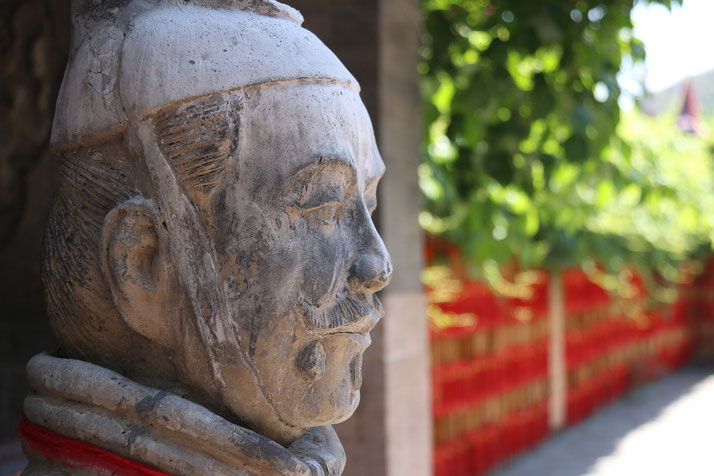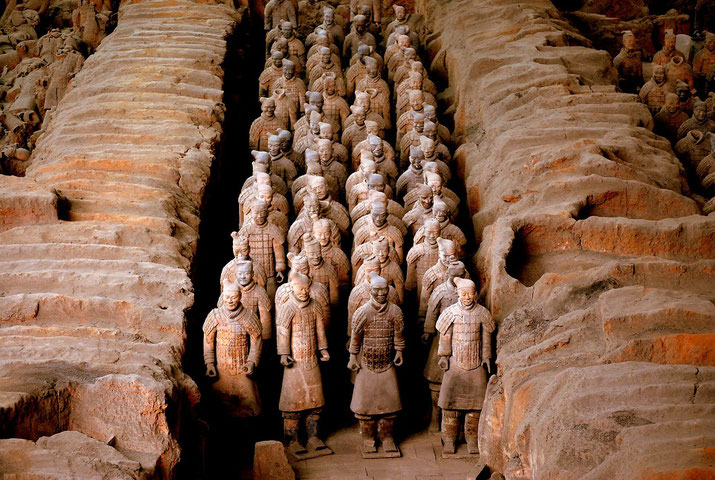Qin Shi Huangdi: The greatest Chinese emperor?

The Warring States period of ancient Chinese history (481 - 221 BC) devastated the country through constant warfare.
It only came to an end when one person, Ying Zheng, the leader of Qin people, managed to conquer the rest of the competing states within China.
Ying Zheng then founded the Qin Dynasty, which only lasted for a brief period, from 221 – 206 BC.
Ying Zheng named himself Shi Huangdi (also spelled Qin Shihuang), which means ‘The First Emperor of the Qin’.
Despite its short existence, the Qin Dynasty was important in setting the stage for later dynasties and for creating a sense of what a Chinese empire should look like.
The Qin Empire
Following his final victories against his opponents in 221 BC, Shi Huangdi focused on enforcing his laws through the newly formed empire.
The emperor reorganised his country by seizing control of all farmlands and dividing it into new government areas that were placed under the care of his own personal officials.
His armies also expanded his empire to the south and absorbed much of the region of modern southern China.
Shi Huangdi wanted to create a single empire that followed the same rules. To achieve this, he restructured many aspects of the people’s lives.
The emperor introduced a new calendar that everyone had to use, and the clothes people wore had to follow a specific set of rules so that they were all the same.
The emperor also created a single form of Chinese writing and a unified monetary system.
He also set up a new capital city at Xianyang and brand-new highways were constructed which allowed quicker access to all parts of his empire for his armies and traders.

The emperor decided that the best way to make sure that people followed his rules was to be very strict when implementing them.
Therefore, Qin Huangdi sent governors out with soldiers across his kingdom to announce and enforce his strict code of laws.
To reduce the number of threats to his new government, Qin Huangdi made it illegal for commoners to carry weapons, and all weapons currently owned by them were confiscated.
In an effort to stop particular leaders raising their own armies against him, the emperor exiled a number of nobles from his lands, while others he ordered to live with him in his capital city so that he could keep a careful eye on them.
However, the Chinese people and those he conquered were not happy with his new, strict rule and there were many armed rebellions.
It appeared that people were spreading revolutionary ideas through books and letters.
So, in 213 BC, Qin Huangdi ordered that any books that were not officially printed by his government were to be burned.
The emperor’s soldiers created large public bonfires where they carried out this order.
The emperor also considered the Confucian scholars of his kingdom to be a dangerous threat to his power, since they had a habit of criticising him and his rules.
So, any scholar who he didn’t trust, or any that kept books hidden from him, were publicly executed by being buried alive.

The Great Wall of China
Shi Huangdi not only faced threats from among his own people, but also from foreign invaders.
This was not new, as previous Chinese states had started building defensive walls along the edges of their lands to stop external tribes from attacking them.
The most worrying threat was from a nomadic group called the Xiongnu, who lived just to the north of China.
Now that the various regions of China were unified under the control of Shi Huangdi as their single leader, the emperor ordered that all of the separate defensive walls be linked together to create a single, large defensive structure across northern China.
This would be the Great Wall of China.
To date, the Great Wall of China is the largest single construction project undertaken by a country.
It measures over 5000 kilometres in length and is protected by 30,000 towers. At the time, it was an average of 7 metres high and up to 5 metres wide, in order to provide enough room for soldiers to walk along its top.
In order to achieve this monumental feat of engineering, Shi Huangdi forced his peasants to undertake hard labour.
The work was difficult and dangerous, and it is estimated that over a million died during its construction.
Some people have nicknamed it the ‘long graveyard’ for this reason.

The death of Shi Huangdi
Shi Huangdi had worked hard to create a unified kingdom and to make sure his enemies were defeated.
He also wanted to make sure that his hard work would last into the future.
As a result, the emperor wanted to find a way to ensure that he could live forever.
He ordered his officials to travel the lands and to foreign countries to find the secret to immortality.
He also hired fortune-tellers and magicians who he hoped knew the information he wanted.
He never did find the answers he was after and he eventually died when he was 49 years old, in 210 BC.
He had been on a journey at the time and his most trusted advisor, Li Si, had to take charge of the kingdom.
Li Si knew that if people found out that the emperor was dead, there would be an outbreak of rebellions across the country.
So, Li Si pretended that the emperor was still alive and had to find a way of getting the body back to the capital city before people found out.
To hide any bad smells which might reveal his secret, Li Si paid for a wagon of rotting fish to join their two-month long journey home.
This also bought him time to create a fake document from the dead emperor that named his heir and successor.
Shi Huangdi was buried in an enormous burial mound, the size of a hill, near modern Xi'an, which the emperor had begun constructing while he was still alive.
Around this artificial mountain, he had also ordered that thousands of life-sized model clay soldiers should be made and buried with him, so that he could have an army in the afterlife.
Today, these soldiers are known as the Terracotta Warriors. Due to the amount of mercury that the emperor ordered to be used in his tomb, it is too hazardous for modern archaeologists to excavate and remains unopened.
The fall of the Qin
The Second Emperor, known as Qin Er Shi, only held power for a few years. He was just as strict as his father and introduced higher taxes and more forced peasant labour to build further palaces, roads, and to complete Shi Huangdi’s tomb.
Angered by their treatment, the peasants rose up in rebellion between 209 and 206 BC.
The Qin forces were defeated by the rebel leader, Liu Bang, who became the new emperor and founded a brand-new dynasty, called the Han.

What do you need help with?
Download ready-to-use digital learning resources
Copyright © History Skills 2014-2025.
Contact via email
With the exception of links to external sites, some historical sources and extracts from specific publications, all content on this website is copyrighted by History Skills. This content may not be copied, republished or redistributed without written permission from the website creator. Please use the Contact page to obtain relevant permission.





